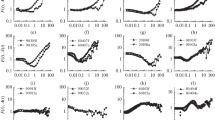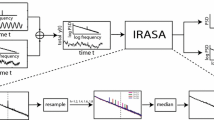Abstract
The behavior of lateral-superior-olive (LSO) auditory neurons over large time scales was investigated. Of particular interest was the determination as to whether LSO neurons exhibit the same type of fractal behavior as that observed in primary VIII-nerve auditory neurons. It has been suggested that this fractal behavior, apparent on long time scales, may play a role in optimally coding natural sounds. We found that a nonfractal model, the nonstationary dead-time-modified Poisson point process (DTMP), describes the LSO firing patterns well for time scales greater than a few tens of milliseconds, a region where the specific details of refractoriness are unimportant. The rate is given by the sum of two decaying exponential functions. The process is completely specified by the initial values and time constants of the two exponentials and by the dead-time relation. Specific measures of the firing patterns investigated were the interspike-interval (ISI) histogram, the Fano-factor time curve (FFC), and the serial count correlation coefficient (SCC) with the number of action potentials in successive counting times serving as the random variable. For all the data sets we examined, the latter portion of the recording was well approximated by a single exponential rate function since the initial exponential portion rapidly decreases to a negligible value. Analytical expressions available for the statistics of a DTMP with a single exponential rate function can therefore be used for this portion of the data. Good agreement was obtained among the analytical results, the computer simulation, and the experimental data on time scales where the details of refractoriness are insignificant. For counting times that are sufficiently large, yet much smaller than the largest time constant in the rate function, the Fano factor is directly proportional to the counting time. The nonstationarity may thus mask fractal fluctuations, for which the Fano factor increases as a fractional power (less than unity) of the counting time.
Similar content being viewed by others
References
Cant N, Casseday J (1986) Projections from the anteroventral cochlear nucleus to the lateral and medial superior olivary nuclei. J Comp Neurol 247:457–476
Cox DR, Lewis PAW (1966) The statistical analysis of series of events. Chapman and Hall, London
Guinan J, Norris B, Guinan S (1972) Single auditory units in the superior olivary complex. II Locations of unit categories and tonotopic organization. Int J Neurosci 4:147–166
Johnson DH, Swami A (1983) The transmission of signals by auditorynerve fiber discharge patterns. J Acoust Soc Am 74:493–501
Johnson DH, Tsuchitani C, Linebarger DA, Johnson MJ (1986) Application of a point process model to responses of cat lateral superior olive units to ipsilateral tones. Hearing Res 21:135–159
Lowen SB, Teich MC (1991) Doubly stochastic Poisson point process driven by fractal shot noise. Phys Rev A 43:4192–4215
Prucnal PR, Teich MC (1979) Statistical properties of counting distributions for intensity-modulated sources. J Opt Soc Am 69:539–544
Prucnal PR, Teich MC (1983) Refractory effects in neural counting processes with exponentially decaying rates. IEEE Trans Syst Man Cybern 13:1028–1033
Saleh B (1978) Photoelectron statistics. Springer, New York
Saleh B, Teich MC (1982) Multiplied-Poisson noise in pulse, particle and photon detection. Proc IEEE 70:229–245
Teich MC (1985) Normalizing transformations for dead-time-modified Poisson counting distributions. Biol Cybern 53:121–124
Teich MC (1989) Fractal character of the auditory neural spike train. IEEE Trans Biomed Eng 36:150–160
Teich MC (1992) Fractal neuronal firing patterns. In: McKenna T, Davis J, Zornetzer S (eds) Single neuron computation. Academic, Boston, pp 589–625
Teich MC, Diament P (1969) Flat counting distribution for triangularly-modulated Poisson process. Phys Lett 30A:93–94
Teich MC, Diament P (1980) Relative refractoriness in visual information processing. Biol Cybern 38:187–191
Teich MC, Khanna SM (1985) Pulse-number distribution for the neural spike train in the cat's auditory nerve. J Acoust Soc Am 77:1110–1128
Teich MC, Matin L, Cantor BI (1978) Refractoriness in the maintained discharge of the cat's retinal ganglion cell. J Opt Soc Am 63:386–402
Teich MC, Johnson DH, Kumar AR, Turcott RG (1990a) Rate fluctuations and fractional power-law noise recorded from cells in the lower auditory pathway of the cat. Hearing Res 46:41–52
Teich MC, Turcott RG, Lowen SB (1990b) The fractal doubly stochastic Poisson point process as a model for the cochlear neural spike train. In: Dallos P, Geisler CD, Matthews JW, Ruggero MA, Steele CR (eds) The mechanics and biophysics of hearing. Springer, New York, pp 354–361
Tsuchitani C (1982) Discharge patterns of cat lateral superior olivary units to ipsilateral tone-burst stimuli. J Neurophysiol 47:479–500
Tsuchitani C (1988) The inhibition of cat lateral superior olivary unit excitatory responses to binaural tone bursts. II. The sustained discharges. J Neurophysiol 59:184–211
Tsuchitani C, Boudreau JC (1966) Single unit analysis of cat superior olive S-segment with tonal stimuli. J Neurophysiol 28:684–697
Tsuchitani C, Johnson DH (1985) The effects of ipsilateral tone burst stimulus level on the discharge patterns of cat lateral superior olivary units. J Acoust Soc Am 77:1484–1496
Vannucci G, Teich MC (1978) Effects of rate variation on the counting statistics of dead-time-modified Poisson processes. Opt Commun 25:267–272
Young ED, Barta PE (1986) Rate responses of auditory nerve fibers to tones in noise near masked threshold. J Acoust Soc Am 79:426–442
Zacksenhouse M, Johnson DH, Tsuchitani C (1992) Excitatory/inhibitory interaction in the LSO revealed by point process modeling. Hearing Res 62:105–123
Zook J, DiCaprio R (1988) Intracellular labeling of afferents to the lateral superior olive in the bat. Hearing Res 34:141–148
Author information
Authors and Affiliations
Rights and permissions
About this article
Cite this article
Turcott, R.G., Lowen, S.B., Li, E. et al. A nonstationary Poisson point process describes the sequence of action potentials over long time scales in lateral-superior-olive auditory neurons. Biol. Cybern. 70, 209–217 (1994). https://doi.org/10.1007/BF00197601
Received:
Accepted:
Issue Date:
DOI: https://doi.org/10.1007/BF00197601




